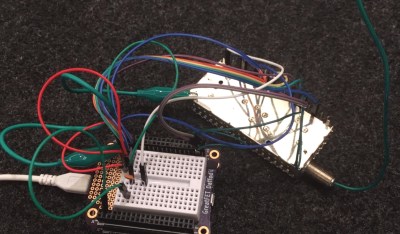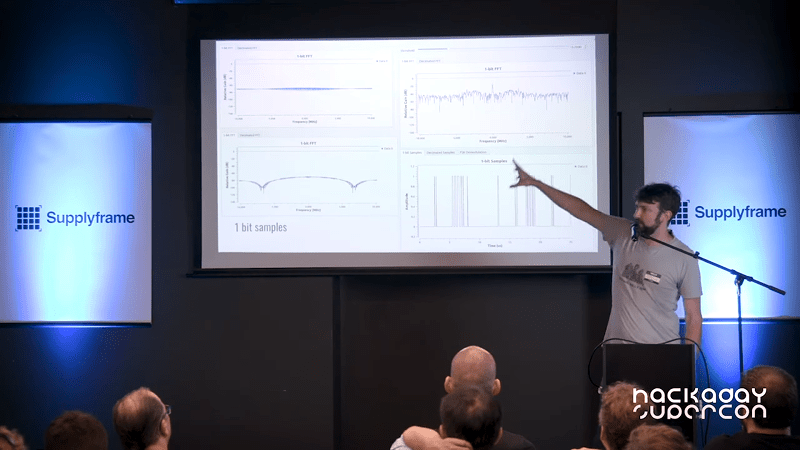There were plenty of great talks at this year’s Supercon, but we really liked the title of Dominic Spill’s talk: Ridiculous Radios. Let’s face it, it is one thing to make a radio or a computer or a drone the way you are supposed to. It is another thing altogether to make one out of things you shouldn’t be using. That’s [Dominic’s] approach. In a quick 30 minutes, he shows you two receivers and two transmitters. What makes them ridiculous? Consider one of the receivers. It is a software defined radio (SDR). How many bits should an SDR have? How about one bit? Ridiculous? Then you are getting the idea.
Dominic is pretty adept at taking a normal microcontroller and bending it to do strange RF things and the results are really entertaining. The breadboard SDR, for example, is a microcontroller with three components: an antenna, a diode, and a resistor. That’s it. If you missed the talk at Supercon, you can see the newly published video below, along with more highlights from Dominic’s talk.
Is It Microcontroller Abuse?

Of course, he’s leveraging the analog conversion in the microcontroller as well as the ability to generate signals in software. You might think that’s going to be an anemic receiver. Granted, it won’t be a high fidelity long-range receiver, but it does interface with GNU Radio!
The ability for the microcontroller to produce signals means you can make transmitters, too. One of the boards in use is a GreatFET One which is actually made for prototyping USB devices. However, by using the clock generation intended for USB, you can get a flexible signal-generating platform.
These aren’t always extremely practical, but it isn’t just a lab curiosity, either. For example, one demo uses an RF entry system for his car, so it isn’t like the techniques won’t work in the wild. Another does direction finding. There’s bound to be something to catch your interest and there are plenty of links to dig deeper on what catches your fancy.
We love projects that turn things into radios, like the time Charles Lohr (Cnlohr) turned an ESP8266 into a TV transmitter. We’ve even seen a few FPGA transmitters. But our latest fascination was when Ted Yapo turned that USB-to-Serial adapter into a functional transmitter.
Update: The slides from Dominic’s talk are now available (PDF).
















I love this.
If you look at Sigma/Delta and delta/sigma, it is based on a 1 bit ADC with feedback and the resulting bit stream.
Anyone know more about the front end diode? He calls it a mixer, but it isn’t using a non-linear region to get products of two signals (I think). As far as I can tell, the SDR detectors use a really clever idea – or it would have been invented a lot earlier than the 1990’s. The square wave from the clock, + the diode , makes a switch running at the clock rate. Analog mixers use some kind of circuit to get the multiplication of two signals. In this case turning on and off is the same as multiplying by a square wave. But multiplying by a square wave is he same as multiplying by all the Fourier components of the square wave, or all the odd harmonics of the frequency of the square wave. The one you want, the product of the fundamental and the antenna signal, is obtained by digital filtering.
At least I think that is how early SDR’s were worked out and this single diode and resistor do that as well. The clock signal lifts the antenna signal above the diode’s conduction level in an on/off manner, which makes it a high frequency switch multiplying by a square wave.
Gosh… the headline made me think article was sbout CONTENT, not technology. I have one of the highest rated multi band radios on the market covering AM-FM, MW & SW… Yet scanning around for over an hour I could not find a single song or program I WANTED to listen to. That is how rediculous radio CONTENT has become.
Why I am always overly cautious of the wireless systems being implemented more-so. Seems the content is more and more misfeasance if not used for malicious acts that you can’t turn off with the receiver switch or a plug in the wall.
About all I enjoy listening to over the air are the NOAA Weather Reports seems.
I thought it was defined not designed.
It is
Right . It is.
Spell checker error. Fixed.
I did something similar with a MachXO2 FPGA. A magnetic loop antenna is directly connected to an LVDS input then sampled at 136 MHz. There is a NCO that is mixed with the 1 bit input and a CIC filter decimates by 4096. Then an IIR highpass and a FIR lowpass for the audio band and a PWM for DAC. Its output pin is fed through an RC filter then goes to a speaker.
I can receive several medium wave stations.
About the microcontroller receiver: the most clever implementation I know of is http://www.sdradio.eu/weaksignals/armradio/index.html
Unfortunately the code as is requires some non-free libraries. I did a porting that uses the ST libraries and it works fine, not polished like the original but OK.
i need 50THz processor
Open source 6Ghz to THz Mid Mid-IR would be nice… I suppose is more cost effective over a certain range in the IR region. Below a certain range… get’s more expensive. NIR is cost effective and readily available… yeah… cost effective Mid-IR… wouldn’t that be nice… especially with MEMS Michelson interferometer or something way high resolution broad range.
Or did you mean a processor chip and rest of circuit chipset??? Yeah… I doubt it. That tech is being held out for hackable 2.4GHz and newer 5.8GHz mass produced consumer good ranges devices since that and older radio tech can spectrum analyze like nothing. The 2.4GHz stuff goes back to the 50’s in the Soviet Union and probably earlier. May be the same somewhat declassified other frequencies older tech… though not so mass produced… especially for consumer electronic devices from what I understand. To fast to intercept and decode is my guess.
Can anyone provide additional information about the mechanism for mixing shown in the first part of this talk? I have never seen this sort of technique to bring the data down to a baseband using a clock output.
I guess this is a still stripped down version of the unbalanced diode mixer…
https://makezine.com/2009/06/26/getting-to-know-the-diode-mixer/
Hmm… This isn’t particularly helpful to me either. It still feels rather hand-wavy, I need more of a focus on the kinds of signals that are going in, instead of just the effects :-/ I don’t even know how I’d begin to breadboard this.
A drunken chimp could get his Technician ticket. Why would someone who’s interested in radio not take such a minimal leap?